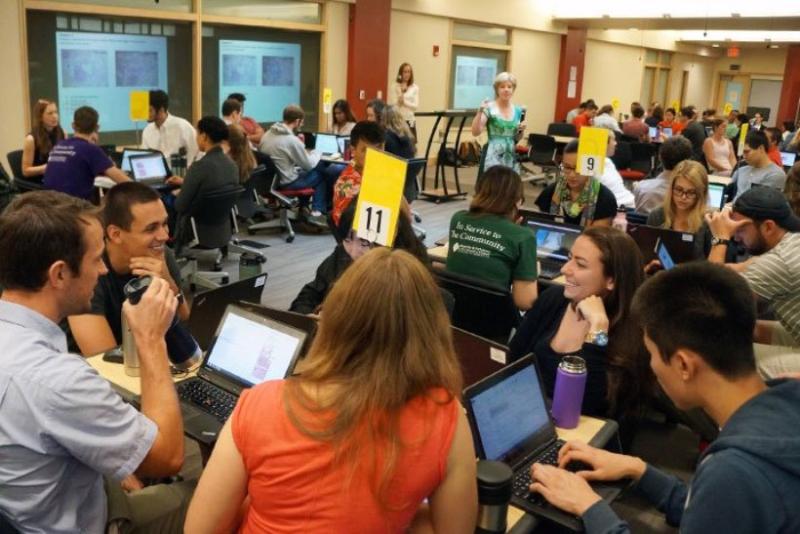Due to their many similarities, the flipped classroom and the inverted classroom are frequently used interchangeably. Nonetheless, there is a significant difference between these two models, which predominantly relates to the emphasis on active learning and student-centred activities. In a flipped classroom, students acquire new material outside of class through pre-recorded lectures, videos, or other digital resources, while in-class time is devoted to active learning activities such as discussions, problem-solving, and collaborative group work. In this model, the teacher acts as a facilitator or guide, assisting students in applying their newfound knowledge and comprehension.
In contrast, the inverted classroom places a greater emphasis on active learning and student-centred activities. While digital resources are still used to deliver content outside the classroom, the focus shifts to a more immersive in-class experience. In an inverted classroom, the teacher fosters a highly interactive and collaborative atmosphere where students take ownership of their learning and engage in meaningful discussions, exploration, and problem-solving. In a nutshell, while both flipped and inverted classrooms utilise technology to move content delivery outside of the classroom, the primary difference rests in the degree to which in-class time is devoted to active learning and student-centred activities. In contrast to the flipped classroom, the inverted classroom emphasises immersive, interactive learning experiences in the classroom.
What is a Flipped Classroom?
The flipped classroom is a new way to teach that turns the traditional teaching model on its head by focusing on the students instead of the teacher. The flipped classroom approach aims to help students learn more, be more involved, and remember what they have learned by changing class time. In a “flipped classroom,” students learn new information outside of class through pre-recorded lectures, videos, or other digital tools. This lets them go through the information at their own pace and as often as needed. The flipped classroom frees up valuable class time for more engaging, interactive activities by giving material delivery as homework.
Students participate in active classroom learning activities, such as group talks, problem-solving, group projects, and peer tutoring. Teachers act as guides or facilitators by giving students support, feedback, and explanations as they use their new knowledge and learn more about the subject. This student-centred approach encourages students to take charge of their learning and helps them build critical thinking, communication, and problem-solving skills. In essence, the flipped classroom model improves the learning experience by using technology to provide flexible, personalised content delivery and using class time for active, collaborative learning that promotes higher-order thinking and meaningful engagement with the subject matter.
What is an Inverted Classroom?
The inverted classroom is a way of teaching that focuses on active learning, tasks that the students lead, and working together in the classroom. The inverted classroom is similar to the flipped classroom in that it uses technology to deliver material outside the classroom. However, the main goal is to create an immersive learning experience in the classroom. In an inverted classroom, students learn about new topics through digital tools like pre-recorded lectures, videos, or online readings that they can access outside of class. This lets them learn at their own pace, go over the information as often as needed, and come to class ready to talk and do activities.
During class time, the teacher’s job changes from lecturing to helping students learn. The main goal is to create a setting where students can have deep, meaningful conversations, explore, solve problems, and do group activities. In this setting, students take charge of their learning and work together to put what they know to use and learn more about the subject. The most important thing about the inverted classroom is that it focuses on active learning and tasks that the students lead. The inverted classroom helps students learn critical thinking, communication, and problem-solving skills by creating an immersive and engaging learning setting. It also encourages a feeling of community and collaboration among students.
Difference Between Flipped Classroom and Inverted Classroom
Both the flipped classroom and the inverted classroom use digital resources and move traditional lecture-style instruction to the student’s own time and space outside of class. However, the main difference is based on how they spend their time in class. In a flipped classroom, students and teachers spend class time working together on meaningful projects. The goal of an inverted classroom is to make class time more of an immersive, dynamic, and collaborative learning experience. Student-centred learning and active involvement are emphasised in both models. Still, the inverted classroom emphasises the in-class experience by encouraging more in-depth conversations, discovery, and problem-solving. There are several fundamental differences between the flipped classroom and the inverted classroom, despite the fact that the terms are commonly used interchangeably.
Emphasis on Active Learning
While the flipped classroom sets a premium on student participation, the inverted classroom takes this to an even higher level by giving more weight to hands-on activities during class time.
In-class Activities
Active learning exercises and some teacher-led instruction are common in flipped classrooms, while inverted classrooms devote nearly all class time to student-centred activities, discussions, and collaborative problem-solving.
Teacher’s Role
The teacher’s position in a flipped classroom is more akin to that of a guide or facilitator. In contrast, in an inverted classroom, it is more about encouraging student-led discussions and group work.
Content Delivery
Outside of class, both systems employ digital resources to convey knowledge. Still, the inverted classroom may use various materials, such as online readings and interactive modules, to promote more active learning.
Flexibility
While the inverted classroom is more prescriptive in its focus on maximising in-class active learning, the flipped classroom model allows teachers more leeway in striking an appropriate balance between content delivery and in-class activities.
Assessment
Formative assessments, including group projects, presentations, and peer evaluations, are commonly emphasised in inverted classrooms, while regular exams may still be used in a flipped classroom.
Class Preparation
Students in inverted classrooms are expected to be more prepared for class since they will be more involved in class discussions and problem-solving activities.
Implementation
Although both methods necessitate a change in pedagogical approach, the inverted classroom may necessitate a more radical transition because of its focus on student-centred learning and in-class collaboration.
Despite their differences, flipped and inverted classrooms both aim to improve education by making better use of technology and encouraging more student participation and independent study. Educators’ and students’ individual requirements, goals, and personal preferences should guide their decision between the two methods.






